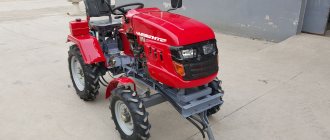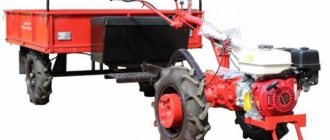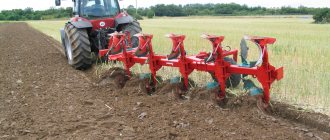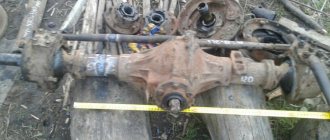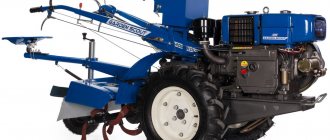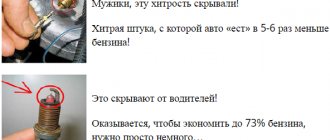Description
This turner attachment is designed to perform two tasks:
- tedding hay;
- raking it to one side.
The working part of this type of tractor-mounted equipment (Russian, Finnish, Polish or Turkish) in most cases consists of four or five wheels. They all rotate in the same direction in a plane that is perpendicular to the direction of movement of the mini tractor.
In this case, the outermost wheel is slightly ahead of the others, the second is slightly behind, the third is even further, then the fourth and fifth. They all rotate in the same direction.
Each wheel has many metal rods around its perimeter, which are slightly curved at the edge in the shape of a hook.
Tedder rake
In raking mode, work occurs as follows.
The wheels, according to the instructions, rotate in such a way that the very first wheel, located on the right (if you face the direction of movement), picks up the hay scattered on the surface of the ground with metal rods and throws it to the side so that it falls under the second wheel. Then in exactly the same way he throws it under the third, then under the fourth, then under the fifth. The last wheel throws the hay to the left, where it, having been collected from the entire working strip of the rake-tedder, is folded into one row.
There are several options for working:
- You can make one pass, then in the opposite direction, so that all the hay ends up in one row, where it will be much easier to collect.
- You can make three passes in one direction, gradually moving the collected hay in one direction. In this case, you will have to collect three times as much hay from one row.
There are other possible operating schemes that can be followed on the tedder rake in this mode.
In the tedding mode, the tractor driver rotates the frame with impellers 180 degrees. In this case, the rightmost wheel will be located at the rear. The hay he picks up will not fall on other wheels. The same can be said about each of the wheels.
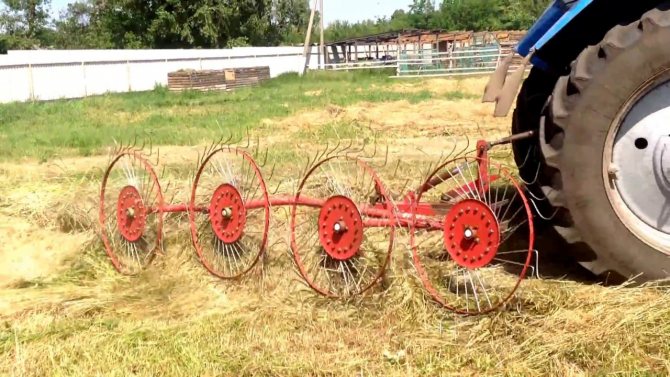
Tedder rake at work
Technical and operational characteristics of the project
| Index | Unit | Magnitude |
| Mechanism type | mounted tooth-type rake-tedder for a single-axle walk-behind tractor 8-13 l. With. | |
| Power point | walk-behind tractor | |
| Working elements | garden fork blades | |
| Tedging width | m | 1,4 |
| Performance | ha/h | not installed |
| Weight limit | kg | 50 |
A thick-walled steel pipe with a diameter of 25 mm and a length of 1.4 m is the basic part of the tedder.
For 6 garden forks with 3 tines, the tubular elements of fastening to the handle are cut off. The blanks are evenly distributed along the length of the base pipe and welded to it.

The support shoes (can be replaced with wheels) are bent from the steel strip and are attached to the base pipe through a unit that allows for changing the installation height and fixation.
To swing the tedder within 10° relative to the walk-behind tractor, a through hole for the cotter pin is drilled at the end of a larger diameter pipe, and slots for the cotter pin are formed on the other pipe.

Fork pins and support shoes
The design is extremely simplified; home craftsmen can criticize, modify and improve it. Homemade hay tedder and walk-behind mower significantly simplify the technology of hay harvesting and reduce time costs.
To mechanize heavy manual labor on personal plots, in private households and agricultural farms, at dachas, many useful machines and mechanisms have been developed to perform a wide variety of work: plowing the soil, sowing crops and planting seedlings, cutting and mowing grass, making hay, improving lawns, transportation of crops.

Experienced and prudent owners have long come to the conclusion: instead of purchasing special equipment for each type of work, it is much more expedient to use a walk-behind tractor or a walk-behind cultivator in combination with various additional devices as traction force.
After all, by installing various attachments on a walk-behind tractor, like on a food processor, you can perform almost the entire range of agricultural work, while saving a significant amount. Agree, not every owner can afford to purchase a whole fleet of special equipment, often expensive.
Let's figure out which attachments are optimally combined with walk-behind tractors for cutting grass and making hay: mowers, lawn mowers, rakes, tedders, various balers, hay pickers, trimmers, etc. And for what type of gardening and agricultural work is this or that type of equipment most suitable - mowing lawns, making hay, laying grass in windrows, mowing weeds and chopping.
How to use and care for the turner
Since the design of the walk-behind rake is quite simple, it does not require constant maintenance. If a linkage is installed on the turner, the device will last a very long time. The farmer will have to periodically lubricate, affecting all rotating and connecting points. This will ensure uninterrupted and smooth operation. It is also worth paying close attention to the chain drive. The chain should not constantly fly off, so that this does not cause blocking of the rotating elements.
If over time one of the parts of the structure becomes unusable, it can be easily replaced with a new one. If the farmer wants to provide the turner with additional safety, he can equip this mechanism with special protective screens. During the work, you should also not forget about safety precautions, which it is better to familiarize yourself with even before picking up the tools.
Overview of attachments
Compact tractors are used in almost all sectors of agriculture. Many attachment devices are designed specifically for soil cultivation. There are various devices for cultivating soil, caring for plants and farm animals.
Attachments for a mini tractor
Note! To install front and other attachments on the tractor, use a mechanical three-point hitch on a mini tractor.
Rake-tedder for walk-behind tractor
This type of equipment is also called “Sun”. Thanks to their design features, they not only allow you to remove hay or leaves from the area, but also turn it over. Due to this, uniform drying of the hay is achieved, which provides it with a long shelf life. You can also use the “Sun” to move piles of hay from place to place.
For preparing significant reserves of hay, multifunctional tedders are one of the farmer’s main assistants, as they allow you to complete in a few minutes the amount of work that would take several hours, or even days, without the use of special equipment. “Solnyshko” are produced in several modifications, from two to four wheels. All have the same principle of operation, but differ in their dimensions and performance. Large diameter tedders can rake hay into piles 2 m or more high, while turning it if necessary. Such indicators make it possible to remove hay from an area of more than 1 hectare in one working hour, which would take a day without the use of a walk-behind tractor.

Drawing for the manufacture of equipment
Let us note that on sale you can find the “Solnyshko” rake models, which have increased power, which allows you to effectively remove cut tree branches and even stir up clods of earth. The main thing is to purchase high-quality equipment, since the design of tedders consists of several elements, it is necessary that they are all made of durable material. Only in this case will the rake have an unlimited period of operation. Videos of their work can be found on the Internet.
Operating principle of various models
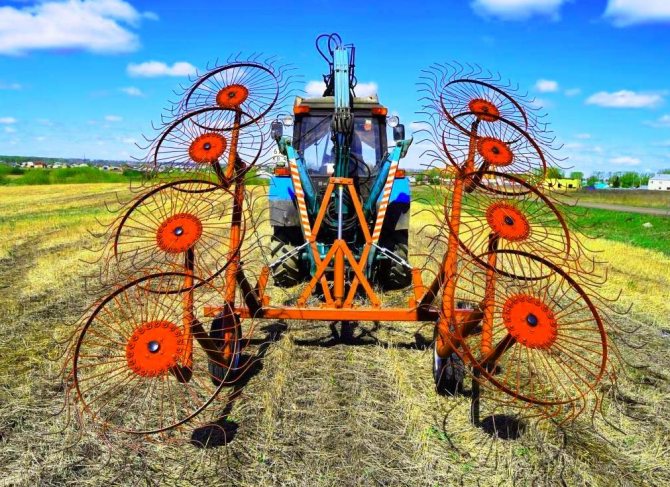
Operating principle of various models
The main working element of all types of tractor rakes is the teeth, which are made of high-quality steel, so they are not afraid of stones or other debris.
Models from different manufacturers have their own characteristics, such as, for example, the method of mounting the wheel hub: on roller bearings or nylon bushings; option for installation on a tractor of one model or another.
According to the nuances of their design, tractor rakes are divided into three subgroups:
- rotary (rotary) are designed from replaceable raking elements mounted on the right and left rotors, while some of them perform raking and turning functions, the second - ted and scatter the resulting windrows; rotors can work in pairs or one at a time; these are one of the most expensive models of this type of agricultural machinery;
- Wheel-finger rakes have, as a working mechanism, rotating disks with inclined (45 degrees) spring “fingers” (spokes), which grab the hay when the rake moves; the number of spokes on rakes and tedders for tractors and mini tractors is 4 dozen; the movement of the wheels is carried out due to the adhesion of the device to the surface of the field; very productive due to their well-thought-out design, however, they can only roll dry grass;
- The simplest design is for tractor transverse rakes - they are not intended for tedding, they only rake raw materials into windrows that are formed across the tractor travel; the wider the cultivated area and the more powerful the tractor, the better the tractor transverse rakes work; sections and teeth are mounted on hinges.
How to make a rake on a mini tractor
Making hay harvesting equipment yourself is not difficult. Such equipment is perfect for farmers who own small plots of land and mini tractors. The presented version is designed for use in coupling with mini-equipment and is equipped with 5 raking wheels. Before you make a tractor rake with your own hands, you need to prepare the following materials:
Drawings and approximate dimensions.
- metal pipe (often an old motorcycle frame is used);
- brackets for mounting wheels;
- spring steel wire 4-8 mm thick for raking fingers;
- steel sheets for the manufacture of impeller disks;
- 2 bearings in the hubs for each wheel;
- parts for making a hitch for attaching a do-it-yourself tedder to the power plant.
For hubs, it is best to use hubs from Zhiguli, since they have tapered bearings. This will increase the wear resistance and durability of the chassis. The above figure shows the device. It is necessary to be careful when creating a rotor so that in the event of a possible breakdown it does not cause the failure of the power plant, and also does not cause harm to the health of the person operating the equipment.
The best option when manufacturing a rotor assembly would be to use a rear automobile axle. Properly assembled tedders can greatly facilitate the collection and tedding of dry plant mass, as well as its subsequent baling. Rotary rakes are characterized by gentle handling when harvesting crops such as alfalfa. The use of tedder rakes will minimize losses when harvesting haylage.
We invite you to familiarize yourself with Blueberry jam from the freezer - Everything is very simple
Homemade equipment
To make homemade equipment for a walk-behind tractor at home, which helps you quickly and efficiently remove hay, the following spare parts are used:
- 2 wheels with a diameter from 30 to 50 cm (you can take car wheels);
- a rod or pipe for metal (the axle is made from it);
- drawbar (made from a profile pipe);
- rods with a diameter of about 6-8 mm (used for teeth);
- springs;
- pipes with a diameter of 3 cm for the axle and 4 cm for fastening.
The entire homemade mechanism consists of:
- drawbar;
- lever;
- a rod that raises and lowers the rake;
- strut;
- racks;
- fork or rake with teeth;
- hubs;
- axles;
- wheels
The following tools should be used:
- hacksaw;
- hammer;
- welding machine;
- hammer drill
Gardeners recommend choosing a folding rake model. They are more convenient and mobile during transportation. It is from a homemade rake that you can achieve speed and mobility in harvesting hay.
Important! All work must be carried out only in accordance with the drawing. You can compose it yourself. During manufacturing, pipe sections are welded into one piece
If the size allows, then they can be inserted very firmly (one pipe into another). The traction mechanism is the rotation of the walk-behind tractor. In this case, there is no need to insert bearings into the wheels. You can choose any rake grip diameter
During manufacturing, pipe sections are welded into one piece. If the size allows, then they can be inserted very firmly (one pipe into another). The traction mechanism is the rotation of the walk-behind tractor. In this case, there is no need to insert bearings into the wheels. You can choose any rake grip diameter.
The first step is to build a base. To do this, wheels are put on the axle. Pads are welded onto the axle to strengthen the fastening of the mechanism. Strips of solid steel are suitable as platforms; they are fixed at a distance of approximately 12 cm from the wheel.
Important! The drawbar is fixed exactly in the center of the wheel axis. The working mechanism is made as follows. Stands are welded onto the wheel axle, to which 2 pieces of pipe with a diameter of 4 cm are also welded.
The rake axis is inserted into it, which should turn freely. Locking rings are made on both sides to prevent the rake from moving to the sides. After performing these operations, the rake is equipped with a lever necessary to change the vertical position of the teeth
Stands are welded onto the wheel axle, to which two pieces of pipe with a diameter of 4 cm are also welded. The rake axle is inserted into it, which should turn freely. Locking rings are made on both sides to prevent the rake from moving to the sides. After performing these operations, the rake is equipped with a lever necessary to change the vertical position of the teeth
The working mechanism is made as follows. Stands are welded onto the wheel axle, to which two pieces of pipe with a diameter of 4 cm are also welded. The rake axle is inserted into it, which should turn freely. Locking rings are made on both sides to prevent the rake from moving to the sides. After performing these operations, the rake is equipped with a lever necessary to change the vertical position of the teeth.
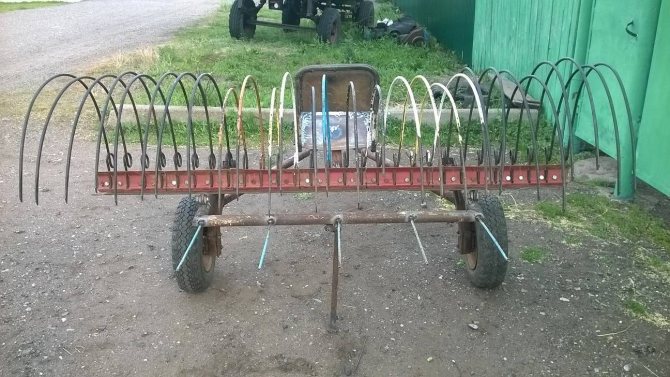
Homemade rake for walk-behind tractor
The teeth are attached to the rake axle. It is recommended to make them from wire with a diameter of at least 6 mm. They are best secured by welding. The stand along with the seat is attached to the drawbar.
Important! It is better to provide the lever with an additional spring so as not to waste effort holding it with your hands. After testing a homemade attachment on a walk-behind tractor, it will be clear whether it is worth correcting possible defects in it. To make it last longer, you should lubricate all parts subject to strong friction with grease.
To make it last longer, you should lubricate all parts subject to strong friction with grease.
After testing a homemade attachment on a walk-behind tractor, it will be clear whether it is worth correcting possible defects in it. To make it last longer, you should lubricate all parts subject to strong friction with grease.
A rake for a walk-behind tractor is a device that greatly facilitates any agricultural work. Models existing on the market are suitable for almost all types of walk-behind tractors. An amateur gardener can easily make a high-quality model of a rake for a walk-behind tractor with his own hands, having simple available tools.
Manufacturing of attachments
DIY tedder rake
Buying canopies for a walk-behind tractor will be very inconvenient for a small summer resident. A summer resident or farmer can make all the equipment himself at home, using a little ingenuity. Most of the equipment is quite simple and can be made from almost whatever is on hand.
Before you make a plow for a mini tractor with your own hands, you need to carefully study the drawings and dimensions and choose the most optimal one. It will be easier to make equipment if you have a ready-made factory circuit.
Description of tractor rakes
Tractor rakes are designed for raking into shafts and subsequent turning over meadow grasses and hay cut during the harvest, as well as for collecting straw after harvesting grain. These operations ensure the yield of high-quality feed products, the duration of their storage and protection from winds.
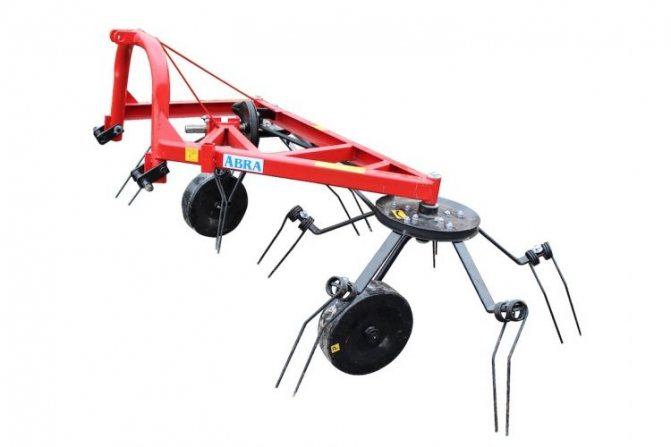
Tractor rake
This unit consists of:
- several sections - rakes with curved spring teeth, which are interconnected by a system of hinges and located at an angle of 45 degrees in the direction of movement;
- a lifting mechanism, it moves the hay/grass forward and to the side, forming a loose windrow;
- support wheels.
For your information. As the rake moves across the field, the teeth, which are rotated by the drive wheel, scoop up all the raw materials lying on the ground. After filling the space between them, the operator starts the automatic tine lift and the cleaning rods push the formed windrow of hay onto the field.
After this, the working unit (teeth) returns to its original state. In areas of small area, the main work is performed by the middle section, the side sections are used for swathing.
Any type of rake of this type, as the name suggests, can only be used with tractors, mini-tractors or monoblocks - they do not have their own power. The rake part is mounted on a frame, where there is a spoke with a trailer, with the help of which the rake is attached to the tractor. The rake bar can be raised or lowered using a hydraulic cylinder, depending on the desired size of the hay windrows.
The rake-tedders are equipped with a floating suspension, which perfectly absorbs when hitting various uneven soils. The wheels of the units are interchangeable and are mounted on a pair of bearings, this makes repair and maintenance work easier.
Types of tedders
The most commonly used type is a hay rake. To harvest it, you need a tool that performs tasks such as raking grass, turning and collecting hay into windrows. These universal tools are turners, which are divided into groups:
- by the nature of manufacturing of the working part;
- by type of traction;
- according to the method of formation of wolves;
- by type of fastening.
By type, such devices for tractors can be divided into two parts:
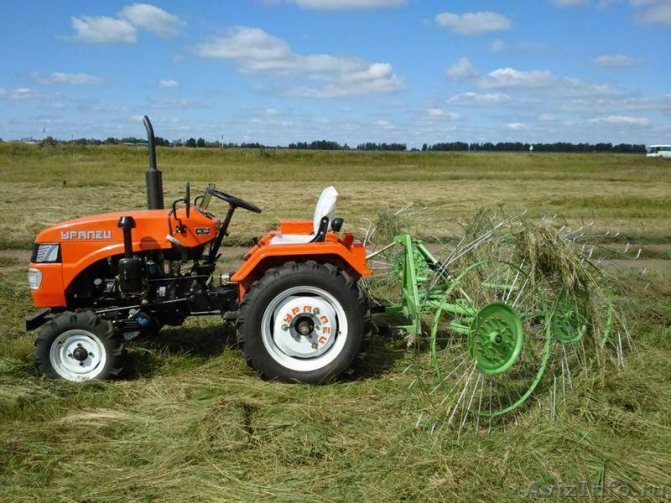
Tedders Sunshine for a mini tractor
- wheel-mounted (for example, Solnyshko tedder rake);
- rotary.
Wheeled ones usually have 3-5 built-in wheels, located obliquely from each other. This increases overall labor productivity. Using the mounted rake of the tedder increases both the gripping area and the thoroughness of raking the grass, and, accordingly, the speed of work as a whole. A simplified repair of the wheelbase is noted in Solnyshka - tractor tedders and rakes have interchangeable wheels secured by two bearings. The most popular among Solnyshko tedders are the GVK tedder rakes, which allow you to rake windrows on both sides at once and turn hay.
Among the advantages of the Solnyshko tedders are:
- low level of labor costs for servicing the mechanism;
- mounted tedder rake ensures longer service life;
- have a powerful traction drawbar and frame (more relevant to factory production);
- convenient transfer of the unit to the working or transport position, which is implemented through the hydraulic system by the tractor operator;
- Convenience of adjusting the pressure of the drive wheels.
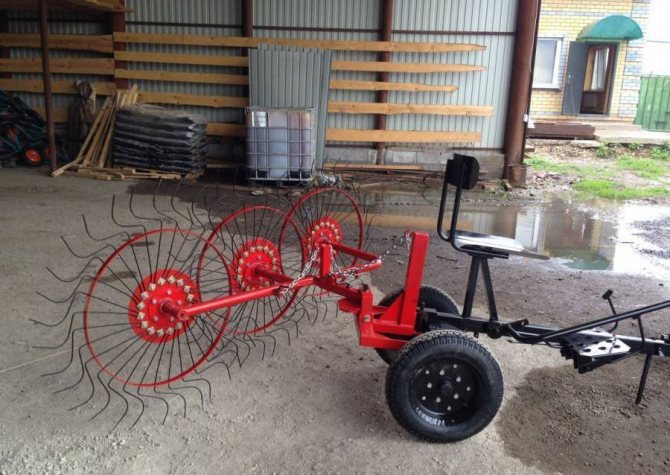
Tedders for walk-behind tractor
Rotary tedder rake includes horizontally located disks (rotors) that are connected to the engine and rotate under the influence of the PTO. Metal pipes with fingers made of iron rods are attached to the rotors. Like tractor rakes, rotary tedders do their “duties” well, but they also have specialization. Their specific direction is collecting hay into compact windrows.
There are also cross tractor rakes. They belong to the mounted type of turners. Transverse devices are designed for raking freshly cut grass with a wide grip. On average, the grip of such instruments is 12-15 meters. to menu
Kinds
All tedders can be divided into several types. For example, rakes differ in the rotation of the working elements when forming transverse and lateral rolls. They are also divided according to the type of working mechanisms:
- wheel-finger, allowing you to make rolls of the required size. This type can only work with dry plant mass and this is perhaps the only drawback. Thanks to the thoughtful design of the rake, tedders of this type are characterized by good performance and are considered the most practical;
- drum or rotary, characterized by structural strength and independent arrangement of raking wheels. They are considered the most expensive models on the agricultural equipment market, but this is justified by their functionality. This type of equipment can not only turn over the mown plant mass, but also form neat windrows from it;
- tooth tedders. Thanks to the design, it is possible to change the angles of inclination of the working elements.
Depending on the type of traction, the equipment can be either tractor or horse. The second type can be used together with a walk-behind tractor. Installation of factory or homemade rakes is possible in three ways:
- trailed (installed on tractors);
- semi-mounted rakes (the most affordable);
- mounted tedders (aggregated with walk-behind tractors and mini tractors).
Rotary tedders are considered the most expensive, so many people prefer to do it themselves, especially since there are no problems with spare parts. They can be purchased in specialized stores or removed from old equipment. Making your own rake is not that difficult; all you need is the desire and experience in handling a plumbing tool.
We invite you to familiarize yourself with Tomato Long Keeper description and characteristics of the variety: yield
Types of nozzles
Various attachments can be useful on the farm. Therefore, the more of them the walk-behind tractor has, the better. There are belt rakes, cross rakes, or with turners; the choice depends on the purpose for which the walk-behind tractor will be used (for example, for collecting hay, leaves or garbage) and the model of the equipment. Some types can even be used for collecting snow and cleaning paths.
A huge variety of models are offered by specialized stores. Here you can find any attachments for a walk-behind tractor at very affordable prices. Making a rake yourself will cost much less.
The nozzle is adjustable in width. Its working part is almost 1.5 m. This makes cleaning the area as fast and efficient as possible. At the same time, such a width allows you to conveniently work both in large spaces and in small areas.
A special feature of the rakes for the Neva walk-behind tractor is that they are made on a spring basis. As a result of this approach, they are not in one position, but slightly change their amplitude during movement. This allows you to better collect garbage, hay, leaves, etc. Moreover, such attachments are not afraid of stones, so their teeth will not break off. They can be lowered and raised using a special lever.
Important! Some models of attachments are great for clearing snow and clearing yard paths. In specialized stores you can find a huge selection of attachments for walk-behind tractors. The product range is selected taking into account the requirements of the most demanding customers
The product range is selected taking into account the requirements of the most demanding customers
In specialized stores you can find a huge selection of attachments for walk-behind tractors. The product range is selected taking into account the requirements of the most demanding customers.
A special feature of this walk-behind tractor is the presence of a special adapter for different types of attachments. It is suitable for any type of equipment, because the adapter adapts to any size of attachments. The width of the working part of the rake is about 1.5 m. This allows you to perform high-quality agricultural work in areas of different sizes.
The design of the rake has a spring base. Thanks to this, they easily walk along the ground and change amplitude. The rake is quite flexible and works without breaking. The user does not need to change the teeth frequently. The nozzle is lowered and raised using an easily integrated manual mechanism.

Motoblock Neva
Thanks to the well-chosen design of the tedder rake for the Neva walk-behind tractor, you can effectively turn hay and remove straw and leaves. The attachment turns this walk-behind tractor into a productive piece of equipment for solving many important tasks.
With this rake you can:
- cultivate and prepare the soil in small areas (0.2-0.3 ha);
- harvest crops and harvest grass;
- effectively clean garden plots.
Planting equipment
This type of equipment includes potato planters. There are several models of planters, with 1 and 2 rows. They also have different tank sizes for planting tubers. Different agricultural enterprises and individual owners can choose tanks of various sizes.
Homemade potato planters for mini tractors are a universal unit. They cut a furrow and throw out planting material, that is, potato tubers, at an equal distance. After this, the planting is automatically covered with soil. All these operations are performed while the mini-tractor is moving around the site. If it stands, then planting potatoes is impossible.
The power of the planters is from 24 horsepower and more. Weight – about 180 kg.
Important! The potato planter should only be used on farms with a large area. The use of attachments in summer cottages and garden plots is ineffective and impractical.
Hiller is equipment for covering the planting site of agricultural crops with soil. Plants are processed in rows. Works the same as a seeder.
Homemade hay rake
To make a wooden hay rake, you will need several types of wood. Usually the cutting is made from coniferous trees. The block and teeth must be made of hard hardwood: birch, elm, ash, rowan. It is better to take wood without knots.
Homemade hay rake
Main characteristics of wood species:
- Pine has hardness, lightness, resistance to moisture, biostability, and strength.
- Birch wood is light, durable and easy to work with.
- Elm has strength, hardness and elasticity comparable to oak wood. Water-resistant, but difficult to process with cutting tools.
- Ash is superior in strength to oak and is resistant to deformation.
Block
A rake for harvesting hay begins to be made from a block. The bark is removed from the birch log and then dried in a dark and dry place. The shape of the block can be straight or curved. Pad parameters:
- length – 50-60 cm;
- width – 5 cm;
- height – 3 cm.
On a note! Use a sharp 10 mm drill to drill holes for the teeth in the block. The roughness of the walls of the holes will allow the teeth to stay more securely in the grooves. The diameter is from 10 to 15 mm, the pitch is 40 mm.
Between the holes for the teeth, make a pair of square or round holes for the future fork of the handle. In this case, perpendicularity must be maintained.
Teeth
The same wood is used for the teeth as for the block. You can take a birch stump 135 mm long. The end side of the chock is drawn into squares with a side of 13-15 mm. Using a hatchet, the log is split according to the markings. Using a sharp knife, each of the blanks is brought to the desired tooth shape.
Teeth on a rake
Each tooth consists of a working part and a head. The length of the head is determined by the thickness of the block. Its diameter should exceed the diameter of the hole in the block by 1-2 mm. This will ensure a strong, tight fit of the tooth. Sharp edges must be blunted to avoid tearing up the walls of the hole when the tooth is seated. The working part of the tooth is from 95 to 100 mm in length. The ends of the teeth are formed using a knife.
To avoid the block from splitting, a wedge-shaped clamp is used when seating the teeth in the holes. The teeth are driven into the holes using a hammer or mallet. To avoid the teeth falling out and losing, you can secure them with nails.
Cutting
The handle for homemade work should be made of spruce or pine. Its length is 170-180 cm, diameter - from 30 to 35 mm. If a freshly felled tree is used, it must be cleared of bark, dried in a vertical position and the surface given a smooth finish.
At the end of the handle, a cut is made for a fork about 25 cm deep. This can be easily done using a longitudinal hacksaw.
Important! When moving the ends of the fork apart, the handle may split. To prevent this from happening, it is necessary to install a metal coupling at the junction of the handle with the fork, securing it with 2 nails
The ends of the fork are moved apart in different directions at a distance of about 10 cm.
Rake handles
Round or square spikes are made at the ends of the resulting fork; their shape and size must correspond to the holes cut in the block. After this, you can put the block with teeth on the spikes of the fork of the handle. Wooden wedges are used to secure the structure.
Final stage
The rake handle should be sanded so as not to injure your hands during operation. The block and fork should be coated with protective agents: oil paint or waterproof varnish. The hay rake is ready.
Hay rakes have served gardeners for many years, being an indispensable element of gardening equipment.
Interesting fact. Residents of Japan give each other rakes on New Year's Eve to rake in happiness.
vote
Article Rating
